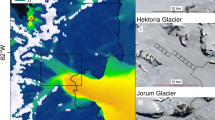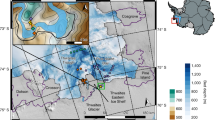Abstract
Basal motion of glaciers is responsible for short-term variations in glacier velocity1,2,3,4,5,6. At the calving fronts of marine-terminating outlet glaciers, accelerated basal motion has led to increased ice discharge and thus is tightly connected to sea level rise1,7. Subglacial water passes through dynamic conduits that are fed by distributed linked cavities at the bed, and plays a critical role in setting basal motion8. However, neither measured subglacial water pressure nor the volume of water in storage can fully explain basal motion2,3,4,5,6,8,9. Here, we use global positioning system observations to document basal motion during highly variable inputs of water from diurnal and seasonal melt, and from an outburst flood at Kennicott Glacier, Alaska. We find that glacier velocity increases when englacial and subglacial water storage is increasing. We suggest that whenever water inputs exceed the ability of the existing conduits to transmit water, the conduits pressurize and drive water back into the areally extensive linked cavity system. This in turn promotes basal motion. Sustained high melt rates do not imply continued rapid basal motion, however, because the subglacial conduit system evolves to greater efficiency. Large pulses of water to the bed can overwhelm the subglacial hydrologic network and incite basal motion, potentially explaining recent accelerations of the Greenland Ice Sheet3, where rapid drainage of large surficial melt ponds delivers water through cold ice10.
This is a preview of subscription content, access via your institution
Access options
Subscribe to this journal
Receive 12 print issues and online access
$259.00 per year
only $21.58 per issue
Buy this article
- Purchase on Springer Link
- Instant access to full article PDF
Prices may be subject to local taxes which are calculated during checkout



Similar content being viewed by others
References
Rignot, E. & Kanagaratnam, P. Changes in the velocity structure of the Greenland Ice Sheet. Science 311, 986–990 (2006).
Iken, A. & Bindschadler, R. A. Combined measurements of subglacial water pressure and surface velocity of Findelengletscher, Switzerland: Conclusions about drainage system and sliding mechanism. J. Glaciol. 32, 101–119 (1986).
Zwally, H. J. et al. Surface melt-induced acceleration of Greenland Ice-Sheet flow. Science 297, 218–222 (2002).
Anderson, R. S. et al. Strong feedbacks between hydrology and sliding of a small alpine glacier. J. Geophys. Res. 109, F03005 (2004).
MacGregor, K. R., Riihimaki, C. A. & Anderson, R. S. Spatial and temporal evolution of rapid basal sliding on Bench Glacier, Alaska, USA. J. Glaciol. 51, 49–63 (2005).
Sugiyama, S., Bauder, A., Weiss, P. & Funk, M. Reversal of ice motion during the outburst of a glacier-dammed lake on Gornergletscher, Switzerland. J. Glaciol. 53, 172–180 (2007).
O’Neel, S., Pfeffer, W. T., Krimmel, R. & Meier, M. Evolving force balance at Columbia Glacier, Alaska, during its rapid retreat. J. Geophys. Res. 110, F03012 (2005).
Fountain, A. G. & Walder, J. S. Water flow through temperate glaciers. Rev. Geophys. 36, 299–328 (1998).
Bindschadler, R. The importance of pressurized subglacial water in separation and sliding at the glacier bed. J. Glaciol. 29, 3–19 (1983).
van der Veen, C. J. Fracture propagation as means of rapidly transferring surface meltwater to the base of glaciers. Geophys. Res. Lett. 34, L01501 (2007).
Hallet, B. A theoretical model of glacial abrasion. J. Glaciol. 23, 39–50 (1979).
Walder, J. S. & Fowler, A. Channelized subglacial drainage over a deformable bed. J. Glaciol. 40, 3–15 (1994).
Kessler, M. A. & Anderson, R. S. Testing a numerical glacial hydrological model using spring speed-up events and outburst floods. Geophys. Res. Lett. 31, L18503 (2004).
Clarke, G. K. C. Lumped-element analysis of subglacial hydraulic circuits. J. Geophys. Res. 101, 17547–17559 (1996).
Solomon, S. et al. (eds) Climate Change 2007: The Physical Science Basis. Contribution of Working Group 1 to the Fourth Assessment Report of the IPCC 14, 820–821 (Cambridge Univ. Press, Cambridge, 2007).
Parizek, B. R. & Alley, R. B. Implications of increased Greenland surface melt under global-warming scenarios: Ice-sheet simulation. Quat. Sci. Rev. 23, 1013–1027 (2004).
Truffer, M., Harrison, W. D. & March, R. S. Record negative glacier balances and low velocities during the 2004 heatwave in Alaska, USA: Implications for the interpretation of observations by Zwally and others in Greenland. Correspondence. J. Glaciol. 51, 663–664 (2005).
Anderson, S. P., Longacre, S. A. & Kraal, E. R. Patterns of water chemistry and discharge in the glacier-fed Kennicott River, Alaska: Evidence for subglacial water storage cycles. Chem. Geol. 202, 297–312 (2003).
Anderson, S. P. et al. Integrated hydrologic and hydrochemical observations of Hidden Creek Lake jökulhlaups, Kennicott Glacier, Alaska. J. Geophys. Res. 108, 6003 (2003).
Anderson, R. S., Walder, J. S., Anderson, S. P., Trabant, D. C. & Fountain, A. G. The dynamic response of Kennicott Glacier, Alaska, USA, to the Hidden Creek Lake outburst flood. Ann. Glaciol. 40, 237–242 (2005).
Walder, J. S. et al. Local response of a glacier to annual filling and drainage of an ice-marginal lake. J. Glaciol. 52, 440–450 (2006).
Hock, R. Glacier melt: A review of processes and their modelling. Prog. Phys. Geogr. 29, 362–391 (2005).
Singh, P. & Kumar, N. Determination of snowmelt factors in the Himalayan region. Hydrolog. Sci. J. 41, 301–310 (1996).
U.S. National Climatic Data Center, NNDC Climate Data Online, <http://cdo.ncdc.noaa.gov/cgi-bin/cdo/cdostnsearch.pl>, search for McCarthy 3 SW (2007).
Chow, V. T. Open-Channel Hydraulics 200–202 (McGraw-Hill, New York, 1959).
Fountain, A. G., Jacobel, R. W., Schlichting, R. & Jansson, P. Fractures as the main pathways of water flow in temperate glaciers. Nature 433, 618–621 (2005).
Nye, J. F. The flow law of ice from measurements in glacier tunnels, laboratory experiments, and the Jungfraufirn borehole experiment. Proc. R. Soc. Lond. A 219, 477–489 (1953).
Björnsson, H. Hydrological characteristics of the drainage system beneath a surging glacier. Nature 395, 771–774 (1998).
Luckman, A., Murray, T., de Lange, R. & Hanna, E. Rapid and synchronous ice-dynamic changes in East Greenland. Geophys. Res. Lett. 33, L03503 (2006).
Abdalati, W. & Steffen, K. Greenland ice sheet melt extent: 1979–1999. J. Geophys. Res. 106, 33983–33988 (2001).
Acknowledgements
We thank A. J. Vonesh for assistance with fieldwork and S. O’Neel for advice and comments on an earlier draft. We appreciate the insightful and constructive reviews of M. Truffer. UNAVCO provided GPS training and equipment; VECO Polar Resources provided logistical support. This work was supported by a grant from the Geomorphology and Land Use Dynamics Program of the US National Science Foundation to R.S.A. and S.P.A. (EAR-0549566), and Geological Society of America and University of Colorado Graduate Student Research grants to T.C.B. We dedicate this work to the memory of our scientific, intellectual and logistics adviser and host in McCarthy, Ed LaChapelle.
Author information
Authors and Affiliations
Corresponding author
Rights and permissions
About this article
Cite this article
Bartholomaus, T., Anderson, R. & Anderson, S. Response of glacier basal motion to transient water storage. Nature Geosci 1, 33–37 (2008). https://doi.org/10.1038/ngeo.2007.52
Received:
Accepted:
Published:
Issue Date:
DOI: https://doi.org/10.1038/ngeo.2007.52
This article is cited by
-
Understanding the 2004 glacier detachment in the Amney Machen Mountains, northeastern Tibetan Plateau, via multi-phase modeling
Landslides (2023)
-
Impact of glacier changes and permafrost distribution on debris flows in Badswat and Shishkat catchments, Northern Pakistan
Journal of Mountain Science (2023)
-
The seasonal evolution of subglacial drainage pathways beneath a soft-bedded glacier
Communications Earth & Environment (2022)
-
Dynamic response of the Greenland ice sheet to recent cooling
Scientific Reports (2020)
-
Surface melt driven summer diurnal and winter multi-day stick-slip motion and till sedimentology
Nature Communications (2019)



